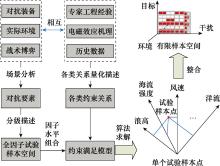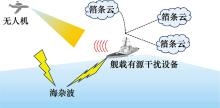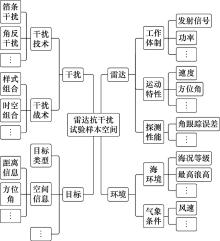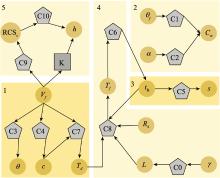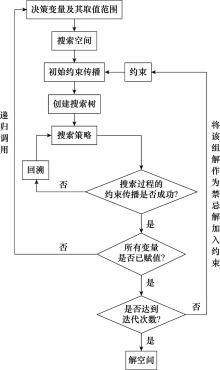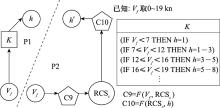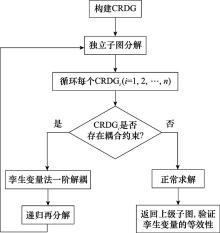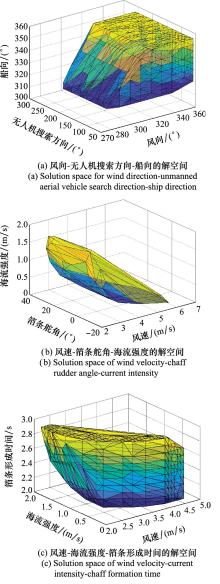Systems Engineering and Electronics ›› 2025, Vol. 47 ›› Issue (7): 2136-2145.doi: 10.12305/j.issn.1001-506X.2025.07.07
• Sensors and Signal Processing • Previous Articles
Spatial characteristics analysis of radar anti-jamming test samples based on coupling constraint satisfaction
Zhitao LONG, Zhijun CHENG, Chen FENG
- School of Systems Engineering, National University of Defense Technology, Changsha 410073, China
-
Received:2024-04-10Online:2025-07-16Published:2025-07-22 -
Contact:Zhijun CHENG
CLC Number:
Cite this article
Zhitao LONG, Zhijun CHENG, Chen FENG. Spatial characteristics analysis of radar anti-jamming test samples based on coupling constraint satisfaction[J]. Systems Engineering and Electronics, 2025, 47(7): 2136-2145.
share this article
Table 1
Factor value range and design level table under each factor"
| 因子名称 | 符号 | 取值范围 | 设计水平 |
| 无人机搜索方向/(°) | α | [0, 45], [315,360] | 19 |
| 雷达开机距离/km | Rk | [10,20] | 11 |
| 方位探测角度/(°) | γ | [10,90] | 10 |
| 距离探测范围/km | L | [1.5, 5] | 9 |
| 舰船运动方向/(°) | Cw | [60,360] | 31 |
| 舰船速度/kn | Vw | [10,30] | 31 |
| 箔条布放策略 | s | 1, 2, 3, 4, 5 | 5 |
| 箔条间距/m | D | [20,100] | 20 |
| 箔条舵角/(°) | θ | [-35, 35] | 71 |
| 箔条发射时机/s | tfs | [-5, 5] | 11 |
| 箔条飞行时长/s | Tf | [1,3] | 3 |
| 箔条形成时长/s | Td | [2,3] | 10 |
| 箔条云发射距离/km | R0 | [1,3] | 3 |
| 箔条的RCS/m2 | RCSc | [20,40] | 21 |
| 风速/kn | Vf | [0, 10] | 100 |
| 风向/(°) | θf | [60,360] | 31 |
| 海流强度/(m/s) | c | [0.05, 3] | 61 |
| 海浪高度/ft | h | [1,8] | 80 |
Table 5
Partial solution corresponding to sequence in constraint graph 1 to 4 after constraint solution"
| 模块 | 部分解 | 模块 | 部分解 | |
| 1 | [60, 110, 315] | 3 | [1, 1] | |
| 1 | [60, 200, 335] | 3 | [1, 2,] | |
| 1 | [70, 140, 335] | 3 | [-2, 3] | |
| 1 | [340, 160, 20] | 3 | [-3, 4] | |
| 2 | [2.2, 8, 1.3, 2.9] | 4 | [1, 10, 1.5, -5, 2, 10] | |
| 2 | [2.6, -1, 1.4, 2.9] | 4 | [1, 17, 2.5, 0, 2, 90] | |
| 2 | [2.8, 28, 0.7, 2.5] | 4 | [2, 16, 4.0, -5, 2, 30] | |
| 2 | [3.0, 30, 0.8, 2.4] | 4 | [3, 18, 4.0, 5, 3, 60] |
| 1 | 程志君,潘正强,刘天宇,等.复杂约束条件下导引头抗干扰试验样本空间分析[J].国防科技,2023,44(4):103-110. |
| CHENGZ J,PANZ Q,LIUT Y,et al.Sample space analysis of anti-jamming tests for seekers under complex constraints[J].National Defense Technology,2023,44(4):103-110. | |
| 2 | 李岩松,王超,戎建刚,等.复杂电磁环境量化表征方法研究综述[J].航天电子对抗,2020,36(6):23-27. |
| LIY S,WANGC,RONGJ G,et al.A review of quantitative characterization methods of complex electromagnetic environment[J].Aerospace Electronic Warfare,2020,36(6):23-27. | |
| 3 | 刘蛟,唐莽,王鑫,等.对海作战场景复杂电磁环境仿真技术研究[J].现代雷达,2021,43(8):28-35. |
| LIUJ,TANGM,WANGX,et al.A study on simulation techno-logy of complex electromagnetic environment in sea battlefield[J].Modern Radar,2021,43(8):28-35. | |
| 4 | 王宇,贺英杰,赵海.雷达抗干扰能力指标测试环境设计[J].航天电子对抗,2014,30(4):61-64. |
| WANGY,HEY J,ZHAOH.Design of test environment of radar anti-jamming ability index[J].Aerospace Electronic Warfare,2014,30(4):61-64. | |
| 5 | 邹钊,李娅,李培林.电磁环境复杂度量化及展现方法[J].电子信息对抗技术,2018,33(6):63-66, 75. |
| ZOUZ,LIY,LIP L.Comprehensive research on the quantitative methods of electromagnetic environment complexity[J].Electronic Information Warfare Technology,2018,33(6):63-66, 75. | |
| 6 | 龚卓, 刘家伟, 段晓君, 等. 基于贝叶斯优化的导引头抗干扰性能试验序贯设计方法[C]//第5届体系工程学术会议论, 2023: 701-706. |
| GONG Z, LIU J W, DUAN X J, et al. A Bayesian optimization based sequential design method for anti-jamming performance experiment of seeker[C]//Proc. of the 5th Academic Conference on SoS Engineering, 2023: 701-706. | |
| 7 | 潘正强, 刘天宇, 程志君. 导引头抗干扰性能试验空间构设方法研究[C]//第3届体系工程学术会, 2021: 214-219. |
| PAN Z Q, LIU T Y, CHENG Z J. Research on construction method of seeker anti-jamming performance test space[C]//Proc. of the 3rd Academic Conference on SoS Engineering, 2021: 214-219. | |
| 8 | 周伟江,柳立志,王鑫,等.基于通用型半实物仿真平台的导引头复杂电磁环境构建及试验方法[J].航天电子对抗,2020,36(4):46-50, 64. |
| ZHOUW J,LIUL Z,WANGX,et al.The construction of complex electromagnetic environment and the test method of seeker based on universal semi-physical test platform[J].Aerospace Electronic Warfare,2020,36(4):46-50, 64. | |
| 9 | 杨镜宇,司光亚,胡晓峰.信息化战争体系对抗探索性仿真分析方法研究[J].系统仿真学报,2005,17(6):1469-1472, 1496. |
| YANGJ Y,SIG Y,HUX F.Study on simulation-based exploratory analysis method of information warfare system of system(SoS) encounter[J].Journal of System Simulation,2005,17(6):1469-1472, 1496. | |
| 10 | BINGG,RONGX L,QIANM L,et al.Construction of orthogonal general sliced Latin hypercube designs[J].Statistical Papers,2022,64(3):987-1014. |
| 11 |
刘根,王治华,屈怀远,等.基于多变量优化的恒定应力加速退化试验设计[J].系统工程与电子技术,2021,43(1):267-271.
doi: 10.3969/j.issn.1001-506X.2021.01.33 |
|
LIUG,WANGZ H,QUH Y,et al.Constant stress acceler ated degradation test design based on multivariate optimization[J].Systems Engineering and Electronics,2021,43(1):267-271.
doi: 10.3969/j.issn.1001-506X.2021.01.33 |
|
| 12 | 尤杨. 复杂试验空间下试验设计方法及应用研究[D]. 长沙: 国防科技大学, 2022. |
| YOU Y. Method and application of experimental design in complex test space[D]. Changsha: National University of Defense Technology, 2022. | |
| 13 |
张路路,潘正强,刘天宇,等.基于高斯过程模型的定性定量因子混合补充试验设计方法[J].系统工程与电子技术,2023,45(7):2078-2085.
doi: 10.12305/j.issn.1001-506X.2023.07.18 |
|
ZHANGL L,PANGZ Q,LIUT Y,et al.Supplemental experimental design method of qualitative-quantitative hybrid factor based on Gaussian process model[J].Systems Engineering and Electronics,2023,45(7):2078-2085.
doi: 10.12305/j.issn.1001-506X.2023.07.18 |
|
| 14 | NEMPONTO,ATIFJ,BLOCHI.A constraint propagation approach to structural model based image segmentation and re-cognition[J].Information Sciences,2013,246,1-27. |
| 15 | VANEGASM C,BLOCHI,INGLADAJ.Fuzzy constraint satisfaction problem for model-based image interpretation[J].Fuzzy Sets and Systems,2016,286,1-29. |
| 16 | LUGERG F.Artificial intelligence: structures and strategies for complex problem solving[M].New Jersey:Pearson Education,2005:10-38. |
| 17 | SIOUTIS M, WOLTER D. Dynamic branching in qualitative constraint networks via counting local models[C]//Proc. of the 27th International Symposium on Temporal Representation and Reasoning, 2020. |
| 18 | MOUHOUB M, AL-MARRI H, ALANAZI E. Learning qualitative constraint networks[C]//Proc. of the 25th International Symposium on Temporal Representation and Reasoning, 2018. |
| 19 | 魏毅寅,杨文华.海战场典型干扰对抗场景及反舰导弹应对策略研究[J].战术导弹技术,2020(5):1-8. |
| WEIY Y,YANGW H.Study on typical jamming scenes in naval battle field and countermeasures of anti-ship missile[J].Tactical Missile Technology,2020(5):1-8. | |
| 20 | 夏雄志,金嘉旺,胡生亮.舰艇编队箔条冲淡干扰效果研究建模与仿真[J].舰船电子工程,2007,27(4):42-44. |
| XIAX Z,JINGJ W,HUS L.Modeling and simulation of re search on the effect of ship formation chaff dilution interference[J].Ship Electronic Engineering,2007,27(4):42-44. | |
| 21 | 李健辉. 对反舰导弹箔条干扰方法研究[D]. 西安: 西安电子科技大学, 2021. |
| LI J H. Research on chaff-jamming method foranti-ship missile[D]. Xi'an: Xidian University, 2021. | |
| 22 | 冯兴如,李水清,尹宝树.海气动量通量研究综述[J].海洋科学,2018,42(10):103-109. |
| FENGX R,LIS Q,YINB S.Review of research on momentum flux through air-sea interface[J].Marine Sciences,2018,42(10):103-109. | |
| 23 | 佟玉华,朱文凭,崔树双,等.多路径效应对低空箔条云RCS影响分析[J].光电对抗与无源干扰,1997(4):33-37. |
| TONGY H,ZHUW P,CUIS S,et al.Analysis of the influence of multipath effect on low-level chaff cloud RCS[J].Electro-Optic Technology Application,1997(4):33-37. | |
| 24 | 何国宝,宋广.箔条云雷达截面积(RCS值)的预计方法[J].水雷战与舰船防护,2009,17(4):60-63, 68. |
| HEG B,SONGG.Estimation method for radar cross section of chaff cloud[J].Mine Warfare & Ship Self-Defence,2009,17(4):60-63, 68. | |
| 25 | 郭勇,朱晓川,董金海.影响海上箔条云RCS的因素分析[J].电子对抗技术,2004(3):43-46. |
| GUOY,ZHUX C,DONGJ H.A research on the factors affecting the chaff's RCS[J].Electronic Information Warfare Technology,2004(3):43-46. | |
| 26 | 曾茂生,修继信.多路径效应对低空箔条云RCS的影响[J].航天电子对抗,2008(6):54-55, 58. |
| ZENGM S,XIUJ X.Multi-path effect on the RCS of the low altitude chaff[J].Aerospace Electronic Warfare,2008(6):54-55, 58. | |
| 27 | 管有林,孟庆良,闫鹏武,等.箔条扩散特性与风速研究[J].制导与引信,2022,43(1):12-16. |
| GUANY L,MENGQ L,YANP W,et al.Study on chaff diffusion characteristics and wind velocity[J].Guidance & Fuze,2022,43(1):12-16. | |
| 28 | 司雪圆. 基于约束可满足的航天器自主任务规划方法研究[D]. 北京: 北京理工大学, 2015. |
| SI X Y. Autonomous mission planning method of space craft based on the constraint satisfaction[D]. Beijing: Beijing Institute of Technology, 2015. | |
| 29 | 陈永府,黄正东,陈立平.数值与符号的耦合约束求解模型[J].计算机工程与设计,2008,29(11):2806-2808, 2837. |
| CHENY F,HUANGZ D,CHENL P.Model for solving numerical and symbolic coupling constraints[J].Computer Engineering and Design,2008,29(11):2806-2808, 2837. | |
| 30 | 陈永府. 基于三维几何模型的计算机辅助工艺规划技术[D]. 武汉: 华中科技大学, 2006. |
| CHEN Y F. Research on computer aided process planning based on three dimensional geometric models[D]. Wuhan: Huazhong University of Science & Technology, 2006. |
| [1] | JIA Xiang, WANG Xiao-lin, GUO Bo. Reliability evaluation for exponential distribution under non-equal type-I censoring [J]. Systems Engineering and Electronics, 2016, 38(6): 1470-1475. |
| Viewed | ||||||
|
Full text |
|
|||||
|
Abstract |
|
|||||
